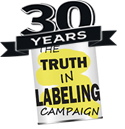CHEMICAL POISONS
How is it fabricated?
-- FORTHCOMING
What roles does it play?
-- FORTHCOMING
Ingredient names used to hide free glutamate
Where is free glutamate hidden in food?
Adverse reactions it is known for
-- FORTHCOMING
Evidence for brain damage
-- FORTHCOMING
Abnormalities associated with glutamate-induced brain damage
-- FORTHCOMING
History of the Jekyll and Hyde amino acid
-- FORTHCOMING

Recognizing Adverse Reactions
When free glutamate is used in food, it is called a food, and reactions to its free glutamate are called adverse reactions. When free glutamate is used in drugs, it’s called a drug, and reactions to it are called side effects. Glutamic acid is an excitotoxic – brain damaging – amino acid. It does the same damage regardless of how it is used and whether it is used in food or in drugs.
By law, the names of all ingredients used in any given food must be named on their food ingredient labels. But the fact that there is or is not free glutamate in an ingredient will not be disclosed.
By law, the names of ingredients used in drugs, to which consumers have indicated they had adverse reactions, must be identified in the inserts enclosed with each drug.
Free glutamate is an excitotoxic – brain damaging – amino acid, no matter how it is produced, or what it is said to be used for.
Recognizing or diagnosing adverse reactions to free glutamate is extremely difficult.
The strangle-hold that chemical, food, pharmaceutical, cosmetic, fertilizer, and pesticide industries have on the lives of Americans are nowhere better illustrated than in the glutamate industry's ability to guarantee that free glutamate be hidden in food, pharmaceuticals, cosmetics, dietary supplements and fertilizer/pesticide products. These industrial giants have promoted the fiction that the pollutants and carcinogens poured into our food, drugs, cosmetics, fertilizers, and pesticides are not pollutants and carcinogens. They, through their wealth and positions of power, are ultimately responsible for medical school curricula that minimize the extent of the toxic effects of certain pollutants and carcinogens - and are ultimately responsible for physicians' failure to look to these pollutants and carcinogens as a basis for much of the disease that currently plagues us. It is they who make generous contributions to universities and medical schools that carry out their research designs. It is they who send friendly scientists on junkets around the world. It is they who are directly responsible for the refusal of the United States government to regulate the use of processed free glutamic acid in food. And our physicians play right along with them.There is no straightforward way to identify free glutamate in food, pharmaceuticals, cosmetics, or dietary supplements. A consumer may have an MSG/glutamate-induced adverse reaction, but since free glutamate in food, pharmaceuticals, cosmetics, and dietary supplements is not identified as such on the label of the product, the consumer may not realize that (s)he has come into contact with free glutamate.
Making matters worse, the glutamate industry (the Glutes) have sold the medical community on the fiction that reactions to "MSG" are allergic reactions--which is not true. The Glutes urge physicians to give allergy tests to people who might be MSG-sensitive, knowing full well that the reaction is a reaction to a toxin, not a reaction to an allergenic substance, and, as such, is not IgE mediated. Traditional allergy tests only identify reactions that are IgE mediated.
The only way to determine if a person is sensitive to free glutamate is to feed free glutamate to that person and observe him or her for as long as 48 hours after feeding; or to have the person keep a record of food, pharmaceutical, cosmetic, and dietary supplement use and any reactions.
Learning to pinpoint free glutamate as a reaction trigger, recognizing reactions that might be glutamate-induced, and understanding where free glutamate is hidden in food, are essential to recognizing or diagnosing glutamate-induced adverse reactions.
Pinpointing the reaction trigger
Glutamate-sensitive people report reactions ranging from simple skin rash to severe depression and life-threatening physical conditions. Two or more reactions occurring together, or one following another, are not uncommon. The amount of free glutamate ingested may play a role in the severity and specific nature of a reaction. The intensity or severity of a reaction also appears to be affected by alcohol ingestion and/or exercise just prior to, or immediately following glutamate ingestion; and some women report variations in their reactions at different times in their menstrual cycles.Diagnosis of glutamate sensitivity is extremely difficult.
None of the symptoms are caused exclusively by free glutamate. Most, if not all, could be caused by various physical conditions, by side effects of neurological drugs or by other food additives. What they have in common is that all are actually reactions to a neurotropic drug -- L-glutamate. Some people eat free glutamate and react immediately.Some react as much as 48 hours later. Of help in diagnosis is the fact that for many people, the time between eating free glutamate and reacting to it is generally the same each time they react.Reactions are dose related. Some people cannot tolerate even the smallest amount of free glutamate. Others tolerate single small amounts, but react when they ingest a gram or more in any one meal. Others can ingest five grams or more, without evidencing a reaction. Canned soups analyzed some time ago, each contained about .6 grams MSG per serving. (MSG always contains free glutamate.) At that time, five grams or more MSG could, at times, be found in a single meal.
The adverse effects of free glutamate ingestion may be cumulative. People have reported eating products containing small amounts once a week without experiencing reactions, while having reactions when those same products were consumed two or three days in a row.
Free glutamate is very often hidden in food. Hiding it makes recognition so complex and confusing that people who are sensitive have a great deal of difficulty pinpointing their sensitivities. If a person reacted after eating something known to contain free glutamate, they might suspect that free glutamate was the culprit. But if that person had the same reaction after eating something that contained free glutamate but did not disclose that fact on the label, they would very likely question his original suspicion. Until all sources of free glutamate are easily identifiable, evaluation of possible glutamate reactions will be difficult. Difficulty in diagnosing is compounded by the industry practice of illegally advertising "No MSG," "No MSG Added," or "No Added MSG" on labels of products that contain free glutamate.
Difficulty in diagnosing glutamate-sensitivity is also compounded by use of fertilizers, pesticides, fungicides, and plant "growth enhancers" that contain free glutamate and leave residues in or on crops when they are brought to market.
Diagnostic tools generally available to physicians are limited to a procedure called "challenge." In a physician's office, an appropriate dose (or doses) of free glutamate would be given to the patient, and provision would have to be made for both restricting the patient's contact with other potential reaction triggers and observing reactions delayed by as much as 48 hours. As an alternative, physician and patient working together may be able to identify, or rule out, glutamate as a reaction trigger through analysis of a patient food diary. Restricting intake to totally unprocessed food and drink for three weeks, then reintroducing items, one at a time, may help identify offending sources of free glutamate.
There are over 60 food ingredients besides monosodium glutamate that contain free glutamate or create free glutamate during the ingredient's production.
Each, according to the FDA, must be called by its own, unique, "common or usual name." "Autolyzed yeast," "maltodextrin," "sodium caseinate," and "soy sauce" are the common or usual names of some ingredients that contain free glutamate.For more information, see Ingredient Names Used To Hide Free Glutamate.
A number of free glutamate-containing ingredients have been designated "organic" by the US National Organic Standards Board. The fact that they may have been made using organic starting materials does not alter the fact that they cause adverse reactions. For sensitive people, "organic" does not mean "safe."
Before it was understood that it is the free glutamate in MSG that causes adverse reactions, one of industry's favorite ways of hiding MSG and its free glutamate was to claim that there is "no added MSG" in a product. If an ingredient that contains free glutamate such as yeast extract is used in a product instead of "monosodium glutamate," the manufacture might make the statement that the product has "no added MSG." If free glutamate is processed into a product instead of being poured into a product, the manufacturer might declare that there is "no MSG added" or "no added MSG" in the product, even though the manufacturer knows full well that the product contains free glutamate. The FDA has deemed that such practice is illegal, but does not enforce its ruling.
In 1997, MSG was introduced in a plant "growth enhancer" (AuxiGro) to be applied to the soil or sprayed on growing crops. It would appear that the use of AuxiGro in the United States has been withdrawn, but it is being used actively in Europe, Asia, Central America, South America, New Zealand, Australia, and Africa.
There are a number of other free glutamate-containing agricultural products being used as fertilizers or being sprayed on growing crops without restriction. Hydrolyzed fish protein and hydrolyzed chicken feathers are two of them.
Letters that Truth in Labeling has received from MSG-sensitive consumers may be helpful in recognizing glutamate-induced adverse reactions.
The following is a list of adverse reactions that might be induced by free glutamate:
Cardiac
ArrhythmiaAtrial fibrillation
Tachycardia...
Rapid heartbeat,
Palpitations
Slow heartbeat
Angina
Extreme rise or drop
in blood pressure
Circulatory
SwellingGastrointestinal
Diarrhea Nausea/vomitingStomach cramps
Irritable bowel
Swelling of hemorrhoids
and/or anus area
Rectal bleeding
Bloating
Muscular
Flu-like achinessJoint pain
Stiffness
Neurological
DepressionMood swings
Rage reactions
Migraine headache
Dizziness
Light-headedness
Loss of balance
Disorientation
Mental confusion
Anxiety
Panic attacks
Hyperactivity
Behavioral problems
in children
Attention deficit disorders
Lethargy
Sleepiness
Insomnia
Numbness or paralysis Seizures
Sciatica
Slurred speech
Chills and shakes
Shuddering
Tinnitus
Visual
Blurred visionDifficulty focusing
Pressure around eyes
Respiratory
AsthmaShortness of breath
Chest pain
Tightness in the chest
Runny nose
Sneezing
Urological / Genital
Swelling of the prostateSwelling of the vagina
Vaginal spotting
Frequent urination
Nocturia
Skin
Hives (both internal and external)Rash
Mouth lesions
Temporary tightness or
partial paralysis
(numbness or tingling)
of the skin
Flushing
Extreme dryness of
the mouth
Face swelling
Tongue swelling
Bags under eyes

